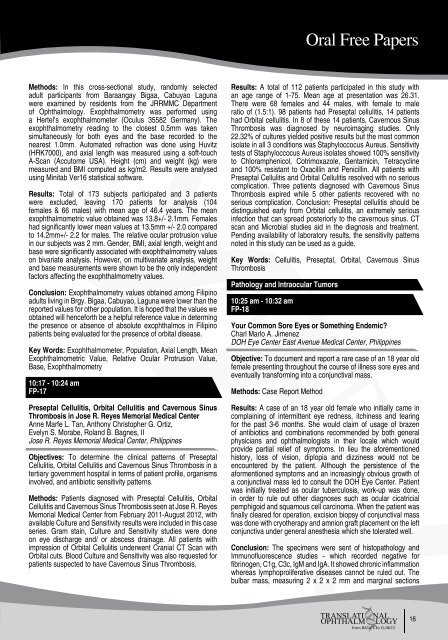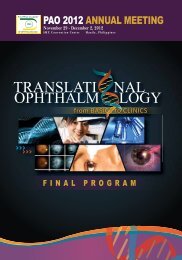Table of Contents - PAO Annual Meeting 2012
Table of Contents - PAO Annual Meeting 2012
Table of Contents - PAO Annual Meeting 2012
You also want an ePaper? Increase the reach of your titles
YUMPU automatically turns print PDFs into web optimized ePapers that Google loves.
Methods: In this cross-sectional study, randomly selected<br />
adult participants from Baraangay Bigaa, Cabuyao Laguna<br />
were examined by residents from the JRRMMC Department<br />
<strong>of</strong> Ophthalmology. Exophthalmometry was performed using<br />
a Hertel’s exophthalmometer (Oculus 35582 Germany). The<br />
exophthalmometry reading to the closest 0.5mm was taken<br />
simultaneously for both eyes and the base recorded to the<br />
nearest 1.0mm. Automated refraction was done using Huvitz<br />
(HRK7000), and axial length was measured using a s<strong>of</strong>t-touch<br />
A-Scan (Accutome USA). Height (cm) and weight (kg) were<br />
measured and BMI computed as kg/m2. Results were analysed<br />
using Minitab Ver16 statistical s<strong>of</strong>tware.<br />
Results: Total <strong>of</strong> 173 subjects participated and 3 patients<br />
were excluded, leaving 170 patients for analysis (104<br />
females & 66 males) with mean age <strong>of</strong> 46.4 years. The mean<br />
exophthalmometric value obtained was 13.8+/- 2.1mm. Females<br />
had significantly lower mean values at 13.5mm +/- 2.0 compared<br />
to 14.2mm+/- 2.2 for males. The relative ocular protrusion value<br />
in our subjects was 2 mm. Gender, BMI, axial length, weight and<br />
base were significantly associated with exophthalmometry values<br />
on bivariate analysis. However, on multivariate analysis, weight<br />
and base measurements were shown to be the only independent<br />
factors affecting the exophthalmometry values.<br />
Conclusion: Exophthalmometry values obtained among Filipino<br />
adults living in Brgy. Bigaa, Cabuyao, Laguna were lower than the<br />
reported values for other population. It is hoped that the values we<br />
obtained will henceforth be a helpful reference value in determing<br />
the presence or absence <strong>of</strong> absolute exophthalmos in Filipino<br />
patients being evaluated for the presence <strong>of</strong> orbital disease.<br />
Key Words: Exophthalmometer, Population, Axial Length, Mean<br />
Exophthalmometric Value, Relative Ocular Protrusion Value,<br />
Base, Exophthalmometry<br />
10:17 - 10:24 am<br />
FP-17<br />
Preseptal Cellulitis, Orbital Cellulitis and Cavernous Sinus<br />
Thrombosis in Jose R. Reyes Memorial Medical Center<br />
Anne Marfe L. Tan, Anthony Christopher G. Ortiz,<br />
Evelyn S. Morabe, Roland B. Bagnes, II<br />
Jose R. Reyes Memorial Medical Center, Philippines<br />
Objectives: To determine the clinical patterns <strong>of</strong> Preseptal<br />
Cellulitis, Orbital Cellulitis and Cavernous Sinus Thrombosis in a<br />
tertiary government hospital in terms <strong>of</strong> patient pr<strong>of</strong>ile, organisms<br />
involved, and antibiotic sensitivity patterns.<br />
Methods: Patients diagnosed with Preseptal Cellulitis, Orbital<br />
Cellulitis and Cavernous Sinus Thrombosis seen at Jose R. Reyes<br />
Memorial Medical Center from February 2011-August <strong>2012</strong>, with<br />
available Culture and Sensitivity results were included in this case<br />
series. Gram stain, Culture and Sensitivity studies were done<br />
on eye discharge and/ or abscess drainage. All patients with<br />
impression <strong>of</strong> Orbital Cellulitis underwent Cranial CT Scan with<br />
Orbital cuts. Blood Culture and Sensitivity was also requested for<br />
patients suspected to have Cavernous Sinus Thrombosis.<br />
Results: A total <strong>of</strong> 112 patients participated in this study with<br />
an age range <strong>of</strong> 1-75. Mean age at presentation was 26.31.<br />
There were 68 females and 44 males, with female to male<br />
ratio <strong>of</strong> (1.5:1). 98 patients had Preseptal cellulitis, 14 patients<br />
had Orbital cellulitis. In 8 <strong>of</strong> these 14 patients, Cavernous Sinus<br />
Thrombosis was diagnosed by neuroimaging studies. Only<br />
22.32% <strong>of</strong> cultures yielded positive results but the most common<br />
isolate in all 3 conditions was Staphyloccocus Aureus. Sensitivity<br />
tests <strong>of</strong> Staphyloccocus Aureus isolates showed 100% sensitivity<br />
to Chloramphenicol, Cotrimoxazole, Gentamicin, Tetracycline<br />
and 100% resistant to Oxacillin and Penicillin. All patients with<br />
Preseptal Cellulitis and Orbital Cellulitis resolved with no serious<br />
complication. Three patients diagnosed with Cavernous Sinus<br />
Thrombosis expired while 5 other patients recovered with no<br />
serious complication. Conclusion: Preseptal cellulitis should be<br />
distinguished early from Orbital cellulitis, an extremely serious<br />
infection that can spread posteriorly to the cavernous sinus. CT<br />
scan and Microbial studies aid in the diagnosis and treatment.<br />
Pending availability <strong>of</strong> laboratory results, the sensitivity patterns<br />
noted in this study can be used as a guide.<br />
Key Words: Cellulitis, Preseptal, Orbital, Cavernous Sinus<br />
Thrombosis<br />
Pathology and Intraocular Tumors<br />
10:25 am - 10:32 am<br />
FP-18<br />
Your Common Sore Eyes or Something Endemic?<br />
Charl Marlo A. Jimenez<br />
DOH Eye Center East Avenue Medical Center, Philippines<br />
Objective: To document and report a rare case <strong>of</strong> an 18 year old<br />
female presenting throughout the course <strong>of</strong> illness sore eyes and<br />
eventually transforming into a conjunctival mass.<br />
Methods: Case Report Method<br />
Oral Free Papers<br />
Results: A case <strong>of</strong> an 18 year old female who initially came in<br />
complaining <strong>of</strong> intermittent eye redness, itchiness and tearing<br />
for the past 3-6 months. She would claim <strong>of</strong> usage <strong>of</strong> brazen<br />
<strong>of</strong> antibiotics and combinations recommended by both general<br />
physicians and ophthalmologists in their locale which would<br />
provide partial relief <strong>of</strong> symptoms. In lieu the aforementioned<br />
history, loss <strong>of</strong> vision, diplopia and dizziness would not be<br />
encountered by the patient. Although the persistence <strong>of</strong> the<br />
aformentioned symptoms and an increasingly obvious growth <strong>of</strong><br />
a conjunctival mass led to consult the DOH Eye Center. Patient<br />
was initially treated as ocular tuberculosis, work-up was done,<br />
in order to rule out other diagnoses such as ocular cicatricial<br />
pemphigoid and squamous cell carcinoma. When the patient was<br />
finally cleared for operation, excision biopsy <strong>of</strong> conjunctival mass<br />
was done with cryotherapy and amnion graft placement on the left<br />
conjunctiva under general anesthesia which she tolerated well.<br />
Conclusion: The specimens were sent <strong>of</strong> histopathology and<br />
Immun<strong>of</strong>luorescence studies - which recorded negative for<br />
fibrinogen, C1g, C3c, IgM and IgA. It showed chronic inflammation<br />
whereas lymphoproliferative diseases cannot be ruled out. The<br />
bulbar mass, measuring 2 x 2 x 2 mm and marginal sections<br />
16



